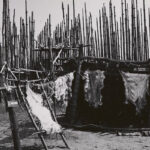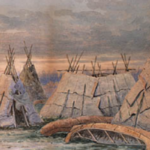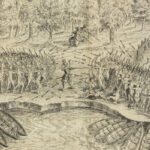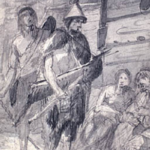The Secwepemc Nation: Guardians of the Interior Plateau
The Secwepemc Nation, whose ancestral territory encompasses the vast Interior Plateau of British Columbia, has thrived in this region for thousands of years. Known for their sophisticated governance, sustainable resource management, and vibrant cultural traditions, the Secwepemc have maintained a deep connection to the land and its resources. Despite the profound disruptions caused by European colonization, the Secwepemc have preserved their identity, advocated for self-determination, and asserted their stewardship over their ancestral lands. Their history is a testament to resilience and continuity.
Ancient Origins: The Interior Plateau and the Secwepemc People
The Secwepemc people trace their origins to the expansive rivers, grasslands, and forests of the Interior Plateau, a region they have inhabited for over 10,000 years. Archaeological sites, including remains of pit houses, fishing weirs, and stone tools, attest to the sophistication of Secwepemc society. The region’s abundance of salmon, game, roots, and berries provided the foundation for a thriving and sustainable way of life.
The Fraser, Thompson, and Columbia Rivers were central to Secwepemc culture, serving as sources of sustenance, transportation, and spiritual meaning. Historian Cole Harris, in The Resettlement of British Columbia, observes, “The rivers and landscapes of the Interior Plateau were more than resources for the Secwepemc; they were integral to their worldview and identity.”
The Secwepemc language, Secwepemctsín, reflects their connection to the land, with place names and stories deeply rooted in the geography of the Interior Plateau. Oral traditions, including the Coyote stories, emphasize the importance of respect for the land and the interconnectedness of all living beings.
Governance and Social Structure
Secwepemc society was organized into over 17 distinct bands, each with its own territories and responsibilities. Governance was conducted through hereditary leadership and consensus-based decision-making. Chiefs, supported by elders and community members, were responsible for managing resources, maintaining relationships with neighbouring nations, and upholding Secwepemc laws and traditions.
The Secwepemc followed a seasonal round, moving between fishing, hunting, and gathering sites to ensure sustainable use of the land’s resources. Marianne Ignace, in Keeping the Stories Alive, writes, “The seasonal movements of the Secwepemc were not only ecological strategies but cultural expressions of their deep understanding of the land.”
Potlatches and feasts were central to Secwepemc life, serving as opportunities for wealth redistribution, conflict resolution, and the reinforcement of social bonds.
Trade and Regional Influence
The Secwepemc were integral to the trade networks of the Interior Plateau, connecting coastal and interior nations through an extensive system of trails and waterways. Their strategic location allowed them to act as intermediaries in the exchange of goods such as salmon, obsidian, and cedar. These trade relationships fostered alliances and cultural exchange with neighbouring nations like the Nlaka’pamux, Okanagan, and Ktunaxa.
Historian Bruce Miller, in Paths of the Coast, emphasizes, “The Secwepemc’s role as intermediaries in the trade networks of the Interior Plateau underscores their economic and cultural influence in the region.”
First Contact with Europeans
European contact with the Secwepemc began in the early 19th century, with the arrival of fur traders from the Hudson’s Bay Company and the North West Company. These interactions were initially centred around trade, as the Secwepemc provided salmon and furs in exchange for metal tools, firearms, and textiles. While these exchanges brought new opportunities, they also introduced devastating diseases.
Epidemics of smallpox, measles, and influenza swept through Secwepemc communities, reducing their population by more than half. Bruce Trigger, in Indigenous Peoples of Canada, describes the impact as “a demographic catastrophe that forever altered the social and cultural fabric of the Secwepemc Nation.”
Colonization and Land Dispossession
The establishment of agricultural settlements, ranches, and transportation infrastructure in the 19th century brought increasing pressures on Secwepemc lands. The imposition of Indian reserves under the Indian Act confined the Secwepemc to small portions of their traditional territories, disrupting their traditional ways of life and limiting access to resources.
Despite these challenges, the Secwepemc resisted cultural assimilation. They continued to practice traditional fishing and hunting, hold ceremonies in secret, and pass down their language and oral histories through storytelling. Historian Robin Fisher, in Contact and Conflict, observes, “The resilience of the Secwepemc in the face of colonial pressures highlights their determination to preserve their culture and identity.”
Cultural Revitalization and Advocacy
The 20th century marked a period of revitalization for the Secwepemc Nation. Efforts to preserve the Secwepemctsín language became central to these initiatives, with language programs and cultural education ensuring that future generations remained connected to their heritage. The Secwepemc also played a significant role in the broader movement for Indigenous rights in Canada.
In 1982, the Shuswap Nation Tribal Council was established to address shared concerns among Secwepemc communities, including land rights, cultural preservation, and self-governance. The council has been instrumental in advocating for the recognition of Secwepemc sovereignty and traditional territories.
Margaret Conrad, in A Concise History of Canada, writes, “The Secwepemc Nation’s leadership in cultural revitalization and land advocacy reflects their resilience and commitment to shaping their future.”
Environmental Stewardship
The Secwepemc have long been recognized for their commitment to environmental stewardship. Their traditional ecological knowledge has guided sustainable practices in fishing, forestry, and land management. In recent decades, the Secwepemc have worked to protect salmon habitats, restore wetlands, and address the environmental impacts of industrial development in the Interior Plateau.
Cole Harris, in The Resettlement of British Columbia, observes, “The Secwepemc’s approach to land management demonstrates a profound understanding of the interconnectedness of ecological and cultural health.”
The Secwepemc Nation Today
Today, the Secwepemc Nation is composed of several communities, including Tk’emlúps te Secwépemc (Kamloops Indian Band), Simpcw First Nation, Splatsin, Adams Lake Band, and others. These communities continue to thrive, balancing traditional practices with modern opportunities for economic development, education, and governance.
The Secwepemc Museum and Heritage Park in Kamloops serves as a hub for preserving and sharing Secwepemc history, language, and traditions. Partnerships with local governments and organizations highlight the Secwepemc’s role as leaders in cultural revitalization and environmental stewardship.
A Legacy of Resilience
The history of the Secwepemc Nation is a testament to their enduring connection to the Interior Plateau and their determination to preserve their culture and traditions. From their ancient stewardship of the land and water to their leadership in cultural revitalization and Indigenous advocacy, the Secwepemc have maintained their identity and place in British Columbia.
As Jean Barman writes in West Beyond the West, “The Secwepemc’s journey is one of continuity and renewal, a reflection of their strength and determination to preserve their place in the lands they have called home for millennia.”
References
- Barman, Jean. West Beyond the West: A History of British Columbia. University of Toronto Press, 1996.
- Carlson, Keith Thor. Living the River’s Legacy: The Fraser River and Coast Salish History. McGill-Queen’s University Press, 2011.
- Conrad, Margaret. A Concise History of Canada. Cambridge University Press, 2012.
- Fisher, Robin. Contact and Conflict: Indian-European Relations in British Columbia. UBC Press, 1997.
- Harris, Cole. The Resettlement of British Columbia: Essays on Colonialism and Geographical Change. UBC Press, 1997.
- Ignace, Marianne and Ronald E. Ignace. Keeping the Stories Alive: Language, Land, and Culture in Indigenous Communities. University of Toronto Press, 2008.
- Miller, Bruce Granville. Paths of the Coast: Trade and Diplomacy in the Coast Salish World. University of Washington Press, 2005.
- Trigger, Bruce G. Indigenous Peoples of Canada. McGill-Queen’s University Press, 1992.
- Shuswap Nation Tribal Council. A History of Resilience: The Secwepemc People. Shuswap Nation Publications, 2000.
- Secwepemc Museum. Voices of the Interior: Preserving Secwepemc History. Kamloops Indian Band, 2010.



